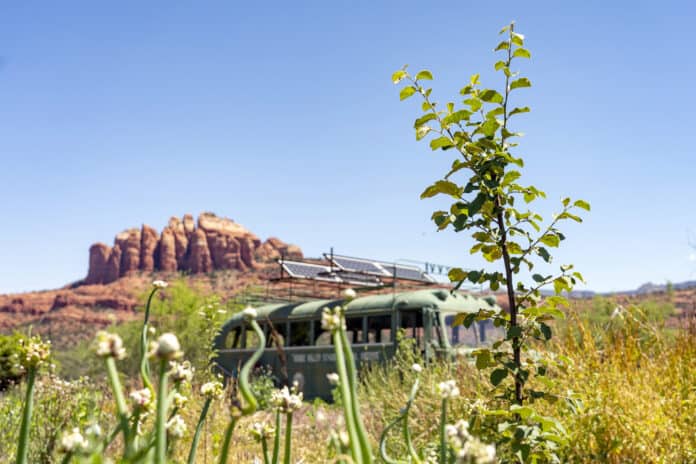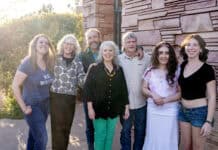
Through the efforts of the Ammucare Charitable Trust’s local affiliate Lori Werner and other local leaders, the Fruit Tree Plantation Drive program has planted 155 fruit trees in the Sedona area this year and is aiming to add more.
The Sedona plantings are part of the program’s goal to plant 100,000 fruit trees across the globe; the group’s website says they are more than 80% of the way to reaching that goal. In Arizona, much of the project has been accomplished through a land and stewardship grant project awarded by the Rob & Melani Walton Foundation. Fruit tree planting is a social responsibility, not just an act of kindness, ACT founder P.K. Mohan, commonly known as Mohanji, said in the group’s annual report.
“This is giving the fruits of kindness to the coming generations beyond species. Fill the forests with fruit trees,” Mohanji said. “Plant more fruit trees in and around your city. It brings sweet grace to our lives beyond time.”
It’s a message that rings true for Werner, who said she was inspired to join ACT after attending a yoga retreat in India. “It was an immediate change for me from selfish to selfless,” she said.
The trust “was originally founded in 2003 in India and will celebrate its 20th anniversary of service [on Thursday] Nov. 9. Mohanji started the trust in honor of his daughter Ammu, who was killed in a road accident at the age of 4,” Werner said. “It all began from one person turning pain into a purpose.”
Locally, the project reminds residents of the area’s agricultural heritage. After homesteader Frank L. Pendley first arrived in Oak Creek Canyon to claim the land that would eventually become Slide Rock State Park, one of his first improvements was to plant an apple orchard in 1912.
“Because of my relationships with people up in [Oak Creek Canyon], I’ve been donating for the last few years at Slide Rock, at Junipine, Orchard Canyon,” Werner said. “We were able to plant 155 fruit trees this year. At all of these properties, also Verde Valley School and one property in Phoenix this year, the Orchard Community Learning Center.”
Slide Rock State Park
ACT’s goal for Slide Rock State Park is to donate 25 trees annually for the next five years, park ranger Kristen Liszewski said. This year’s donation included Wolf River, Jonathan, King David, Grimes Golden and Arkansas Black apple varieties.
“There’s approximately 450 fruit trees on the property,” Liszewski said. “We did specifically request for heritage varieties, and those varieties that were planted when the Pendley homestead was being founded … the Arkansas Black in particular [is] a very dark apple. It’s usually ready a little bit later than our other apples. It’s definitely one of my favorites.”
Park visitors will have to wait about 4-5 years for the orchard’s newest arrivals to start to bear fruit. Until then, visitors can still purchase apples from the park’s existing trees, generally starting the Tuesday after Labor Day in September.
“It depends on the size of the harvest we get,” Liszewski said. “Visitors can come to the ranger station [and] purchase an empty bag, we have different sizes [for] $5 to $10. Then they go out and pick their own apples. If we do get years where there’s big crops, rangers will go out or we’ll get volunteers and pick them ourselves and we’ll sell bags directly to the public.”
This year’s plantings are doing well and park staff are optimistic that they will establish themselves.
Verde Valley School
Verde Valley School received 50 fruit trees to supplement their existing orchard, which effectively doubled the number of fruit trees at the school. VVS has pledged to donate 50% of its harvest to Manzanita Outreach to support its food-sharing program.
“The VVS farm was founded, curated and is managed as a regional model for how a desert agricultural ecosystem can and should be implemented,” the school’s farm manager Michael Spielman wrote to Werner. “It was our intention from the beginning to provide the space, the plants, the experience and the knowledge that could help change the trajectory of sustainable living and land management in the Verde Valley. We look forward to supporting and expanding the growing capacity of this region.”
ACT has handcrafted another 30 trees from 100-year-old trees in Orchard Canyon that have been sent to Trees of Antiquity, a fruit tree nursery that specializes in heirloom apple trees in Paso Robles, Calif. Werner said these are planned to be replanted at Orchard Canyon next year. Around 16 trees went to the Junipine Resort as part of the resort’s efforts at restoring habitat for native pollinators.
“We are so thankful for the fruit tree contribution from ACT Foundation and look forward to sharing the bounty of figs, apples, and pomegranates in the years to come,” Junipine gardener Sarah Estrada said. “These trees are the start of Junipine’s food forest and vegetable garden space that will soon be a creekside dining experience. We hope to educate visitors as they spend time here and spread the knowledge when they are back home.”
“It’s a really beautiful project,” Werner said. “Its intention was to honor the stewards who have been doing and maintaining these historic orchards up in the canyon, like Rob Lautze at Orchard Canyon who has been the steward, maybe for 40 years, he was the original steward at Slide Rock when the state got it from the Pendleys.”
“The most gratifying part of the job is being able to go and market the fruit on the roadside or at the Flagstaff Farmers Market, and people have been coming up from the valley for generations to see their fall colors and get their bag of apples and their jug of cider,” Lautze said during a conversation with Werner.


















